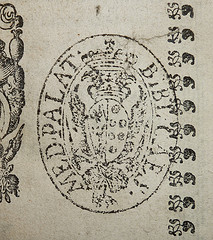The stencil stamp assembly is designed to be compact in size, with excellent ink carrying capacity, high stamping durability, and capable of producing high-quality stamped images. The stencil stamp consists of a handgrip and a stencil stamp assembly.
The stencil stamp assembly includes an ink-bearing component covered with a thermal stencil sheet, which has numerous pores or holes arranged in a pattern. During the stamping process, ink from the ink-bearing component is forced through the pores in the stencil sheet and onto a recording sheet, creating a stamped image.
The ink-bearing component has at least two layers with different densities. The less dense layer is in contact with the thermal stencil sheet, providing a large ink storage capacity. The denser layer has a high ink carrying capability, reducing the risk of ink leakage. The denser layer is also more rigid, minimizing creasing and distortion of the stencil sheet during both the stamping process and the pore pattern formation.
Traditional stamps with rubber stamping components have been used for stamping surfaces of recording sheets with company names, addresses, and other text. Custom stamps are typically made-to-order, resulting in higher costs and longer waiting times.
A thermal stencil sheet has been practically employed for these stamps instead of the rubber stamping component. Pores can be created in a desired pattern on the thermal stencil sheet using infrared beams or a thermal head.
Text strings, patterns, and/or symbols can be printed on a recording sheet by pressing ink through the pores of the stencil sheet.
A stencil stamp assembly, which includes the aforementioned thermal stencil sheet and an ink-bearing component impregnated with ink, is disclosed in Japanese Utility Model Laid-open publication No. Hei 5-74833. This previously proposed stencil stamp assembly can replace conventional rubber-based stamps.
This stencil stamp assembly is constructed by attaching an ink-bearing component impregnated with ink to a frame surrounding it and adhering a thermal stencil sheet to the frame.
When using the stencil stamp assembly on a stamping device, the assembly is attached to a cushion component on the lower surface of the device’s base. The stamping device has a handgrip, and text strings or patterns are created in the thermal stencil sheet using infrared beams or a thermal head. The resulting stamping device can print numerous copies of the desired pattern or text strings on a recording sheet.
In this stamping device, pores can be created in the thermal stencil tape in any desired pattern, as the device includes a supply of blank thermal stencil tape and a thermal pore-forming device that creates pores in the desired pattern input by the user. The stamping component does not require external inking, as ink is automatically applied by the ink-bearing component included in the device.
After a certain amount of ink has been consumed during stamping, the rate of ink supply to the stamping plane decreases. Even if the ink-bearing component still contains a significant amount of ink, it is used inefficiently. As a result, the stencil stamping assembly needs to be replaced before all ink has been used, making the cost of using a stencil stamp relatively high.
An objective of the present invention is to provide a stencil stamping assembly with a compact design, excellent ink carrying capacity, high stamping durability, and high-quality stamping capabilities.
To achieve this goal, the present invention offers a stencil stamping assembly with a base component connectable to a handgrip, an ink-bearing component impregnated with ink and affixed to the base component’s lower surface, and a thermal stencil sheet covering the ink-bearing component’s lower surface to form a stamping element. The ink-bearing component has a laminated structure with at least two layers of different densities. The denser layer is closer to the thermal stencil sheet than the less dense layer.
The ink-bearing component with a lower density layer is capable of carrying a large amount of ink, providing excellent stamping durability for the stencil stamp assembly. The high-density layer has a good ink carrying capacity and prevents ink leakage. Additionally, due to capillary action, ink constantly moves from the low-density layer to the high-density layer, ensuring the high-density layer doesn’t run out of ink. Furthermore, the high-density layer is relatively rigid, withstanding stamping stress and preventing creasing and bending of the thermal stencil sheet.
As evident from the previous description, a stencil stamp assembly based on this innovation has a relatively small size and an ink-bearing component with excellent ink carrying capacity. The lower part of the ink-bearing component is quite rigid, allowing precise pore formation. As pores are created with high accuracy, the stamp can produce stamping patterns with outstanding print quality. The stencil stamp also has impressive stamping durability. Issues related to ink, such as ink leakage, can be resolved by adjusting the characteristics of the ink-bearing component. The stamping device can use ink with relatively low viscosity, and different versions of the stencil stamp assembly can be created to meet specific customer requirements.
Once pores are formed in a desired pattern on the thermal stencil sheet, the stamping element is pressed onto the surface of the recording sheet. Ink held by the ink-bearing component is pushed out through the pores and onto the recording sheet, creating the desired pattern on the recording sheet.
Manuel Marino is a seasoned Senior Producer, Music Composer, and Artist with over a decade of experience. He specializes in branded entertainment across various mediums, including video games, films, and advertising campaigns. With 20+ years as a game music composer, Manuel has worked on numerous platforms, creating diverse orchestral soundtracks. HIRE ME


 Manuel is a passionate, driven, and techsavvy AV technician,
Manuel is a passionate, driven, and techsavvy AV technician, 
